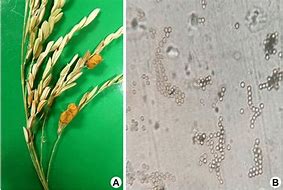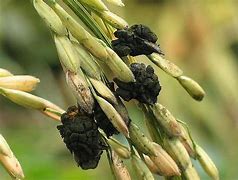User:Cortez10: Difference between revisions
| Line 30: | Line 30: | ||
|} | |} | ||
''Genus species''Ustilaginoidea and ''Villosiclava'' | ''Genus species": ''Ustilaginoidea and ''Villosiclava'' | ||
==Background and Significance== | ==Background and Significance== | ||
Revision as of 10:47, 1 December 2023
Classification


Ustilaginoidea virens
U. virens (anamorphic form)
Subclass: Incertae sedis
Order: Incertae sedi
Family: Incertae sedis
Genus: Ustilaginoidea
Villosiclava virens (V. virens)
V. virens (teleomorph form)
Subclass: Sordariomycetes
Order: Hypocreales
Family: Clavicipitaceae
Genus: Villosiclava
Use NCBI link to find]
Species
|
NCBI: [1] |
Genus species": Ustilaginoidea and Villosiclava
Background and Significance
Rice false smut (RFS) has become a considerable threat to global rice production, exerting a notable impact to affect both yield and grain quality. The fungus Villosiclava virens (V. virens), along with its anamorphic form Ustilaginoidea virens (U. virens), belongs to the Kingdom Fungi, specifically within Phylum Ascomycota and Class Ascomycetes. U. virens, the anamorph form responsible for sexual reproduction, is classified further into Subclass Incertae sedis, Order Incertae sedi, Family Incertae sedis, and Genus Ustilaginoidea. The fungal life cycle involves both asexual and sexual reproduction. The asexual stage (anamorphs) promotes rapid propagation and the sexual stage (teleomorphs) leading to efficient propagation and genetic recombination to generate new strains. The teleomorph form, V. virens, is found in Subclass Sordariomycetes, Order Hypocreales, Family Clavicipitaceae, and Genus Villosiclava, adding layers of complexity to the fungal life cycle (Fan et al., 2016). The flexibility of the fungus to adapt to changing environmental conditions further demonstrates the status of the fungus to cause the disease, rice false smut, to be considered a significant rice pathogen in agriculture production. Rice false smut has a notable impact on rice cultivation, particularly in the regions of China, the United States, and India. (Fan et al., 2016). China is known to tackle an expansive rice false smut disease incidence of 3.06 million hectares of rice fields, which results in an annual yield loss of 158.6 million kilograms. The Yangtze River basin remains a hot spot for rice false smut despite immense efforts between 2008 and 2016 despite attempts to reduce the disease across 6.9 hectares. In these regions, rice false smut incidence in the region continues to persist, ranging from 19% to 40%. India, faces similar struggles of incidence rates in rile tillers that fluctuate between 5% and 85%. These rice tillers are pivotal for grain production because they are susceptible to rice false smut and lead to rice yield loss ranging from 0.2% to 49% (Liu et al., 2023).
Infection
Rise false smut (RFS) infections begin when the fungus Ustilaginoidea virens (U.virens) attacks and infiltrates the rice floral organs. The fungus produces a network of white hyphae for the infection process to occur in the floral organs. As the infection progresses, the fungus then manifests a pigmented dark green chlamydospore within the rice spikelets. In late autumn, the temperature fluctuates throughout the night and day, and the chlamydospore balls are covered with sclerotia. The sclerotia offer the chlamydospore some defense to be resilient The rice false smut also causes blemishes on the rice plant and causes the contamination of the straw and rice grain (Zhang et al., 2014).
Production of Mycotoxins
The fungus releases mycotoxins such as ustiloxins and ustilaginoidins. Villosiclava virens (V. virens) can also produce mycotoxins, ustiloxins, and ustilaginoidins. Ustiloxins are water soluble and there are six identified structures, including A-D. and F. A consortium of genes is proposed to have control over the regulation of the ribosomal synthesis of ustiloxins (Wang et al., 2019). There is also the implication that ustiloxins and ustilaginoidins have pathways and the genes involved are not certain (Zhang et al., 2014). It is known that Ustiloxins A and B are primarily abundant in rice false smut balls. In the early stage of maturation, Ustiloxins A and B can be detected in the middle layer of the mycelia and are also found in immature chlamydospores. While ustilaginoidea can be found in rice's false smut balls or within layers of chlamydospores (Wang et al., 2019). Due to the possible resilience of the fungus U. virens, the production of toxins such as ustiloxin can be affected due to environmental conditions. Ustilotoxins and cyclopeptide mycotoxins have been shown to be harmful to humans and animals, but there has been little research on toxicology studies to reveal the significant health effects affiliated with mycotoxins produced U. virens. For instance, zebrafish exposed to a dose-dependent amount of ustilotoxin A experienced decreased hatching rates, higher mortality rates, and impairment of motor function in zebrafish larvae. Adverse side effects caused by ustilotoxin A caused zebrafish larvae to experience growth delays and increased heart rate. Exposure to mycotoxins caused alterations in the expression of 339 transcripts in larvae (Hu et al., 2019). Overall, there are different types ofU.virens found in rice false smut balls that can produce different varieties of ustilotoxins (Lin et al., 2018).
Ecology and Pathogenesis
Habitat; symbiosis; environmental or industrial relevance; contributions to environment.
If relevant, how does this organism cause disease? Human, animal, plant hosts? Virulence factors, as well as host symptoms.
References
Author
Page authored by _____, student of Dr. Marc Orbach, University of Arizona .
